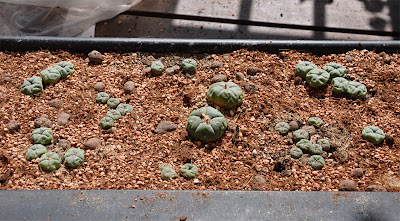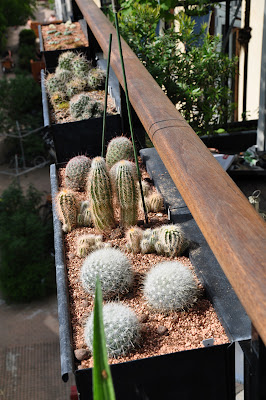40 peyote cacti growing in a window flower box
For the last many years I've experimented with growing peyote, Ariocarpus, Leuchtenbergia, and the likes in an unheated coldhouse in Denmark. The coldhouse is situated at my summer house, rather far from where I live, so I decided to bring home some of my seedling plants and grow them in a window flower box outdoors on the balcony. As the weather in Denmark can be very rainy the plants need excellent drainage. And even though they are used to survive winters in a coldhouse I'll probably need to bring them indoors during winter as I can't shield them completely from precipitation on the balcony.
Flower box planted with peyote and Acharagma
I waited for a sunny period (and a ditto long term weather report :-) before planting a window box with 40 peyote plants and a handful each of Acharagma aguirreana and Acharagma roseana plants.
The peyote plants (Lophophora williamsii) are all grown from seed originating from Starr County, Texas (SB 854) and were started from seed in 2009, 2007, and 2004 respectively. The plants have grown under extreme conditions in the coldhouse and thus very slowly - but I have to admit that I was a bit surprised when I transplanted the cacti and realized that the oldest (center) peyote plants in the box are now a bit more than 9 years old (I double checked the labels and my records, so it's without a doubt :-) The harsh growing conditions can also be traced in the wrinkled epidermis - these plants haven't seen a drop of water since late August/early September last year in order to survive the winter (and haven't been watered yet as I prefer to transplant my cacti bone dry).
Both Acharagma species were started from seed in spring 2009.
Drainage layer of Leca pebbles
I have never grown this type of cacti in window flower boxes before and was very much in doubt of what type of soil to use.
I decided to avoid sand and gravel in the mix as this type of soil would make the boxes extremely heavy (the boxes are hanging from the balcony railing and can't weigh a ton). Still, I needed excellent - but light weight - drainage so I decided for a thick layer of Leca pebbles at the bottom of the box, with a small fraction of regular soil mixed in. Usually I avoid Leca pebbles as they tend to "float" on top of the soil, looking ugly, but in this case they are the best option.
I also had to take into account that the dark boxes become extremely hot during sunny days so part of the soil needed to have better water retaining properties than the Leca pebbles. My solution was to use a top layer consisting of burnt moler cat litter and coir (a natural fibre extracted from the husk of coconut) - both are able to retain water but don't get soggy and waterlogged.
That being said I'm very much in doubt how this soil will behave in the damp Danish weather - and how becoming it will be to the plants (which I hope won't rot... but I'm sure time will tell :-)
Flower box planted with Echinocereus reichenbachii and Mammillaria
Another flower box was planted with Echinocereus reichenbachii originating from material I collected in the Wichita Mountains Wildlife Refuge back in 2007 plus a few Mammillaria grahamii (SB 1860; Steins, New Mexico, USA) and Mammillaria senilis (ROG 214; Tecorichi, Chihuahua, Mexico) plants bought from Kakteen-Haage.
I don't have much experience with growing Mammillaria species but selected these plants for their ability to tolerate cold conditions - and also for their beautiful flowers of course :-) One thing I learnt the hard way is that the fish hook spines of the Mammillaria plants behave like velcro when the plants get too close to each other, i.e. you should be very careful when planting several plants in the same container.
Three cacti window flower boxes on a row
I now have a total of three window flower boxes planted with cacti on the balcony; the two covered in this post plus the box planted with Echinocereus triglochidiatus, Escobaria vivipara (Alberta, Canada), and Escobaria missouriensis (SB204; Mesa County, Colorado). The latter box was planted last year and wintered outdoors on the balcony.
Malpighia 1927 v.30 (added: 11/24/2025)
-
*By:*
Borzi, Antonino,1852-1921.
Penzig, O.1856-1929.
Pirotta, Romualdo,1853-1936.
*Publication Info:*
Messina : g. Capra & co., 1887-89 ; Genova : Tip. di A...
4 weeks ago
























No comments:
Post a Comment